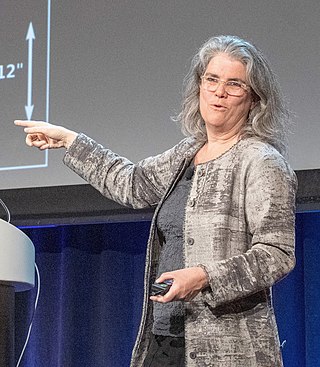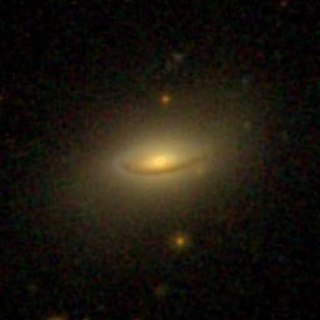Related Research Articles

A globular cluster is a spheroidal conglomeration of stars. Globular clusters are bound together by gravity, with a higher concentration of stars towards their centers. They can contain anywhere from tens of thousands to many millions of member stars. Their name is derived from Latin globulus. Globular clusters are occasionally known simply as "globulars".

The Galactic Center is the rotational center, the barycenter, of the Milky Way galaxy. Its central massive object is a supermassive black hole of about 4 million solar masses, which is called Sagittarius A*, a compact radio source which is almost exactly at the galactic rotational center. The Galactic Center is approximately 8 kiloparsecs (26,000 ly) away from Earth in the direction of the constellations Sagittarius, Ophiuchus, and Scorpius, where the Milky Way appears brightest, visually close to the Butterfly Cluster (M6) or the star Shaula, south to the Pipe Nebula.

Andrea Mia Ghez is an American astrophysicist, Nobel laureate, and professor in the Department of Physics and Astronomy and the Lauren B. Leichtman & Arthur E. Levine chair in Astrophysics, at the University of California, Los Angeles. Her research focuses on the center of the Milky Way galaxy.

IC 1613 is an irregular dwarf galaxy, visible in the constellation Cetus near the star 26 Ceti. It was discovered in 1906 by Max Wolf, and is approaching Earth at 234 km/s.

NGC 4323 is a lenticular or dwarf elliptical galaxy located about 52.5 million light-years away in the constellation Coma Berenices. The galaxy was discovered in 1882 by astronomer Wilhelm Tempel and is a member of the Virgo Cluster.

NGC 299 is an open cluster of stars in the main body of the Small Magellanic Cloud – a nearby dwarf galaxy. It is located in the southern constellation of Tucana, just under 200,000 light years distant from the Sun. The cluster was discovered on August 12, 1834 by English astronomer John Herschel.

NGC 708 is an elliptical galaxy located 240 million light-years away in the constellation Andromeda and was discovered by astronomer William Herschel on September 21, 1786. It is classified as a cD galaxy and is the brightest member of Abell 262. NGC 708 is a weak FR I radio galaxy and is also classified as a type 2 Seyfert galaxy.

NGC 759 is an elliptical galaxy located 230 million light-years away in the constellation Andromeda. NGC 759 was discovered by astronomer by Heinrich d'Arrest on September 17, 1865. It is a member of Abell 262.

NGC 4074 is a peculiar lenticular galaxy located 310 million light-years away in the constellation Coma Berenices. It was discovered by astronomer William Herschel on April 27, 1785 and is a member of the NGC 4065 Group.

NGC 4294 is a barred spiral galaxy with flocculent spiral arms located about 55 million light-years away in the constellation Virgo. The galaxy was discovered by astronomer William Herschel on March 15, 1784 and is a member of the Virgo Cluster.

NGC 4298 is a flocculent spiral galaxy located about 53 million light-years away in the constellation Coma Berenices. The galaxy was discovered by astronomer William Herschel on April 8, 1784 and is a member of the Virgo Cluster.

NGC 4299 is a featureless spiral galaxy located about 55 million light-years away in the constellation Virgo. It was discovered by astronomer William Herschel on March 15, 1784 and is a member of the Virgo Cluster.

NGC 4302 is an edge-on spiral galaxy located about 55 million light-years away in the constellation Coma Berenices. It was discovered by astronomer William Herschel on April 8, 1784 and is a member of the Virgo Cluster.
Sangeeta Malhotra is an astrophysicist who studies galaxies, their contents, and their effects on the universe around them. The objects she studies range from our own Milky Way galaxy to some of the earliest and most distant known galaxies in the epoch of cosmic dawn.

NGC 4800 is an isolated spiral galaxy in the constellation Canes Venatici, located at a distance of 95 megalight-years from the Milky Way. It was discovered by William Herschel on April 1, 1788. The morphological classification of this galaxy is SA(rs)b, indicating a spiral galaxy with no visual bar at the nucleus (SA), an incomplete ring structure (rs), and moderately-tightly wound spiral arms (b). The galactic plane is inclined to the line of sight by an angle of 43°, and the long axis is oriented along a position angle of 25°. There is a weak bar structure at the nucleus that is visible in the infrared.

NGC 4393 is a spiral galaxy about 46 million light-years away in the constellation Coma Berenices. It was discovered by astronomer William Herschel on April 11, 1785. It is a member of the NGC 4274 Group, which is part of the Coma I Group or Cloud.
References
- ↑ "Rafelski, Marc". isee.ucsc.edu. Retrieved 2021-03-26.
- ↑ "Galactic Astronomy at UCLA". www.astro.ucla.edu. Retrieved 2021-03-26.
- ↑ Rafelski, M.; Ghez, A. M.; Hornstein, S. D.; Lu, J. R.; Morris, M. (2007). "Photometric Stellar Variability in the Galactic Center". The Astrophysical Journal. 659 (2): 1241–1256. arXiv: astro-ph/0701082 . Bibcode:2007ApJ...659.1241R. doi: 10.1086/512062 . ISSN 0004-637X.
- ↑ Rafelski, Marc Alexander (2011). Star formation in damped Lyman-alpha systems and the outskirts of Lyman break galaxies (Thesis). UC San Diego.
- ↑ "Marc Rafelski's author profile in INSPIRE". inspirehep.net. 26 March 2021. Retrieved 2021-03-26.
- ↑ "Marc Rafelski". STScI.edu. Retrieved 2021-03-26.
- ↑ Rafelski, Marc; Zaritsky, Dennis (2005). "The Star Clusters of the Small Magellanic Cloud: Age Distribution". The Astronomical Journal. 129 (6): 2701–2713. arXiv: astro-ph/0408186 . Bibcode:2005AJ....129.2701R. doi:10.1086/424938. ISSN 0004-6256. S2CID 4600017.
- ↑ Back, B. B.; Baker, M. D.; Barton, D. S.; Betts, R. R.; Bindel, R.; Budzanowski, A.; Busza, W.; Carroll, A.; Corbo, J.; Decowski, M. P.; Garcia, E. (2002). "Energy Dependence of Particle Multiplicities in Central A u + A u Collisions". Physical Review Letters. 88 (2): 022302. arXiv: nucl-ex/0108009 . Bibcode:2002PhRvL..88b2302B. doi:10.1103/PhysRevLett.88.022302. ISSN 0031-9007. PMID 11801006. S2CID 34600571.
- ↑ "Papers co-authored by Marc Rafelski indexed by NASA/ADS". ui.adsabs.harvard.edu. 26 March 2021. Retrieved 2021-03-26.
- ↑ "Lauren Elmegreen, Marc Rafelski". The New York Times. 2007-08-05. ISSN 0362-4331 . Retrieved 2021-04-01.